Theory of Light and Color

13. Sense of Sight and Color (Part 1)
Color Vision for the Standard Observer
In Chapters 11 and 12, we explained that color comes into existence through the two elements of light (spectral distribution) and sight (eye and brain). Moreover, object color is determined by light, sight, and an object's physical properties (spectral reflection/transmission).
The previous chapters treated the properties of sight as fixed. In reality, there are variations in color vision that affect object color recognition.
Color Sense and Color Perception
It is difficult to quantify the sense of color because it depends on the subjective and psychological responses of the eye and brain. It is easy to figure out whether people can tell one color from the other, but you cannot confirm the exact color they see.
But if we focus on measurable stimuli, we can use psychophysics to measure the relationship between physical stimuli and the psychological sensations and perceptions they produce. In color science, color sense is based on psychophysical measures of the psychological effect of light (physical quantity) as it enters a visual system.
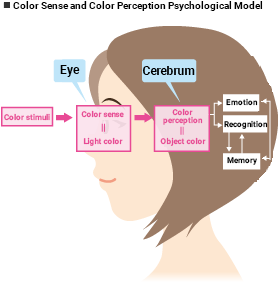
The brain determines color perception using color sense information. There are many examples of how color perception changes when two or more colors that are spatially and temporally adjacent to each other. Color relativity, color assimilation, and color adaptation can all affect how our vision senses color. These are physiological and psychological phenomena related to color perception. Color perception information evokes the emotional effects of colors in the brain.
Individual Differences in Vision and the Standard Observer
The spectral properties of light before entering the eye can be represented as a product of the spectral distribution of the light source P (λ) and the spectral reflectance/spectral transmittance of the object ρ (λ):
P (λ)・ρ (λ)
However, each person sees different brightness and color, even if both the object and P (λ)・ρ (λ) are the same. Representative vision characteristics were adopted to objectively evaluate brightness and color (except when focusing on individual differences themselves).
The standard observer has become the measure of the average human visual characteristics. There are two types of standard observers: the standard photometric observer and the standard colorimetric observer. The former evaluates brightness, and the latter evaluates color. ≪1≫
The standard spectral luminous efficiency V(λ) described in Chapter 1 is a property of the standard photometric observer. The standard colorimetric observer is defined by color-matching functions x(λ), y(λ), and z(λ). The function y(λ) matches the properties of the spectral luminous efficiency V(λ). ≪2≫ The color-matching functions correspond to the wavelength sensitivity properties of the three types of cone cells (L, M, S). x(λ), y(λ), and z(λ) do not match the actual wavelength sensitivity properties of L-, M-, and S-cones themselves but are values transformed for practical use.
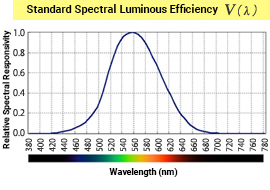
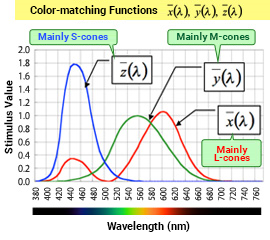
Photopic Vision, Mesopic Vision, and Scotopic Vision: The Function of Cone and Rod Cells
The sensitivity of photoreceptors can also change physiologically depending on ambient light.
You will notice this when you move from a bright place to a dark place and can only see total darkness at first. Your eyes adjust to where you can see the surroundings but not color. When moving from a dark space to a bright area, light feels extremely bright before your vision returns to normal.
These responses result from the different sensitivities between cone cells and rod cells.
Rod and cone cells work to complement each other according to the brightness of the surroundings. Cone cells are extremely active in bright places where they recognize both brightness and colors. Vision in well-lit areas where the cone cells are active is called photopic vision. The range of photopic vision is too bright for rod cells to function.
Scotopic vision is the eye's vision in low lighting, where rod cells are more active. They have a higher sensitivity to light than cone cells but are slow to respond to changes in brightness. Moreover, they can only distinguish brightness and not colors. As time passes in the dark and the rod cells become active, they can sense light that cones cells cannot, and the surroundings are visible.
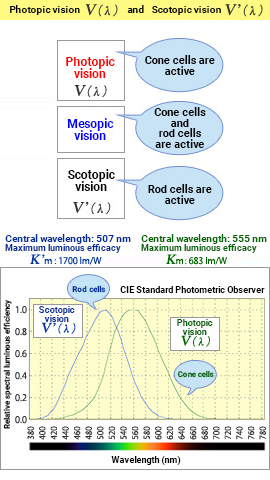
For the standard photometric observer, photopic spectral luminous efficiency V(λ) represents sensitivity in bright environments, and scotopic spectral luminous efficiency V’(λ) represents spectral sensitivity in the dark. ≪3≫ V(λ) combines the properties of the three types of cone cells (L, M, S), while V’(λ) only shows the properties of rod cells. ≪4≫
There is also a state between scotopic and photopic vision. Mesopic vision is when both rod and cone cells are active. The ratio of the activity of both rod and cone cells changes according to the level of brightness.
Comment
≪1≫
The standard observer is officially called the CIE standard photometric observer and the CIE standard colorimetric observer (Commission internationale de l'éclairage).
≪2≫
The RGB color system derived color-matching functions using red, green, and blue monochromatic light. It was impractical because it has a wavelength range where the color-matching function becomes negative. The XYZ color system was then developed by converting the RGB color system through a linear transformation. Color-matching functions corresponding to the XYZ color system are x(λ), y(λ), and z(λ). Each function is derived from the sensitivity properties of L-cones, M-cones, and S-cones, respectively.
≪3≫
The spectral luminous efficiency of photopic vision V(λ) and scotopic vision V’(λ) are specified as a relative value with a sensitivity peak of 1.
Compare the luminous efficiencies (lm/W) of photopic vision K(λ) and scotopic vision K’(λ). Scotopic vision has a higher sensitivity, which is how you can see your surroundings in the dark.
K(λ) = Km・V (λ) ( Km = 683 lm / W )
K ’m (λ) = K ’m・V ’(λ) ( K ’m = 1700 lm / W )
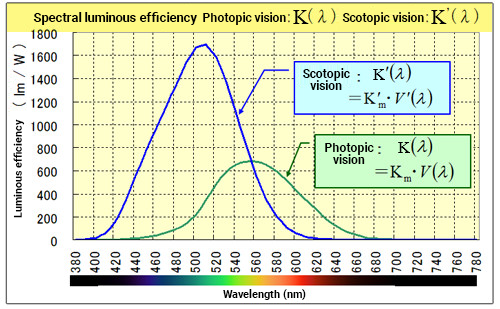
≪4≫
The spectral luminous efficiencies V(λ) and V’(λ) are determined not only by the photoreceptors but also by the cornea, lens, macula, and retina. The characteristics for photopic spectral luminous efficiency V(λ) are mainly derived from the L- and M-cones.

